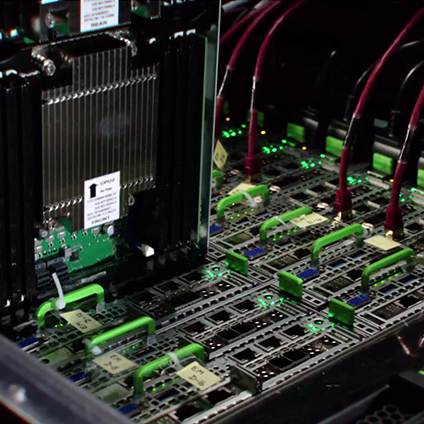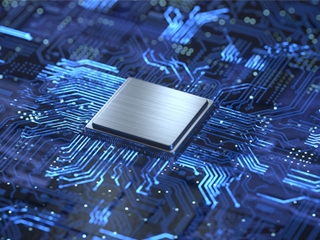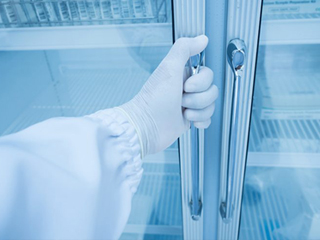Submerging oneself in cold water is a fantastic method to cool down, as anybody who has ever plunged into a body of water during summer heat will attest. Mechanical and thermal experts should not overlook this common-sense observation.
Given that the power utilized by computers has a 1:1 heat-to-electricity ratio IBM invented a method for cooling computer components by immersing them in dielectric fluid. This took place when the computer industry was still in its infancy. Immersion cooling techniques have progressed since those early days. Let’s go over the basics of immersion cooling and the many methods used in practice.
What Is Immersion Cooling?
Air has been the most popular way of cooling IT equipment to date. The fans, ducts, and HVAC systems associated with it take up a lot of room and energy. On the other hand, fluid cooling for IT systems, such as cutting-edge gaming rigs necessitates the use of pipes, pumps, and a large amount of space.
Because immersion cooling saves energy and space. The interest in the technique has increased over time as technology has advanced. But what is immersion cooling?
Immersion cooling entails submerging system components. This includes the motherboard and other computer parts in a dielectric fluid. The procedure necessitates the use of fluids that will not harm IT components. Oils and designed fluids, such as 3M’s Novec or Fluorinert lines, are the two types of dielectric fluids utilized for immersion cooling today.
Single-Phase Immersion Cooling vs. Two-Phase Immersion Cooling
The first technique is called single-phase immersion cooling. In this method, the components are completely submerged in a dielectric fluid, usually oil or an engineered fluid. The fluid absorbs the heat created by the IT components. Then pumps and circulates the fluid around an enclosure, chassis, or tank to remove the heat. Pumping the hot fluid out of the immersion bath to be cooled by a secondary air-to-liquid or liquid-to-liquid heat exchanger and then pumping the cooled oil/fluid back in.
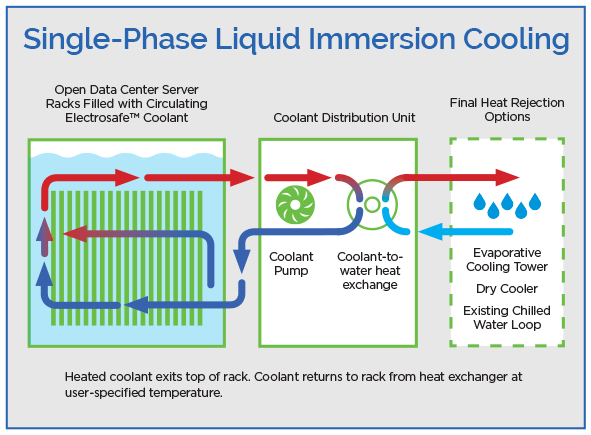
The second method makes use of the heat that is expelled as a result of a phase shift. The IT components are submerged in a dielectric fluid in a single phase. However, this time the fluid is constructed to have a boiling point lower than the temperature of heat-emitting IT components. This includes CPU, GPU, ASIC, power supply, DC converters, and more. When the IT equipment is turned on, the heat is evacuated through a liquid-to-gas phase transition.
The fascinating aspect of phase shift is after the boiling point is achieved, the dielectric fluid itself does not become any hotter. Heat is rejected when the vapor gas comes into contact with a constructed vapor-to-liquid heat exchanger. There is no need for a separate heat exchanger or pumping system because the heat exchange takes place inside the tank. This removes a possible point of failure and reduces the immersion cooling system’s complexity and expense.
The amazing thing about 2-phase immersion cooling is that it requires very little energy to operate. The rising gas generated by the phase shift within the tank condenses on the tubes inside the tank’s top, then transforms back to a liquid in the form of tiny droplets, which fall back into the liquid bath, and the process starts all over again.
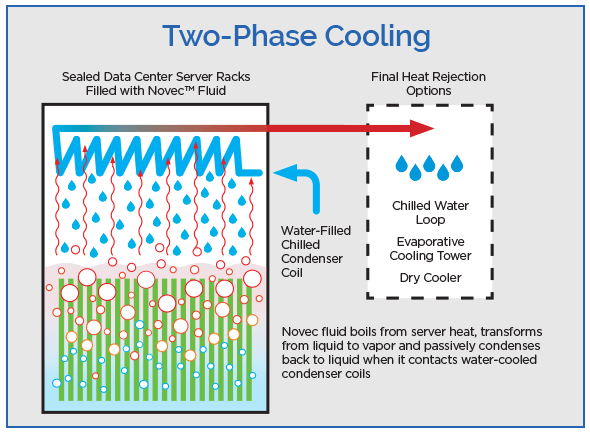
Immersion Cooling Implementation Methods
Two (2) basic methods for implementing immersion cooling.
The first method employs an enclosed IT chassis. The customized chassis provides containment of the dielectric fluid and oftentimes less fluid is needed as a result. Part of the appeal of this method is that it allows self-contained, immersion-cooled chassis to be installed in conventional server racks. A Coolant Distribution Unit (CDU) can likewise be used to manage the coolant across many chassis. A major challenge of this approach is that the immersive chassis must be replaced with every IT refresh. This will be around an average of 10 complete replacements over the usable life of the IT rack.
The second method employs an enclosed IT tank. The tanks provide containment of the dielectric fluid. These tanks are designed to accommodate IT gear that would otherwise be mounted in 19”, 21” or OCP style racks for example. Since the tanks accommodate almost all types of IT gear there is no need to replace the tank for an IT refresh. This makes the flexibility, cost, and total cost of ownership (TCO) appealing for tanks. This is against the chassis approach whereas the approach enjoys the benefit of dielectric fluid volume savings.

Immersion Cooling and the Sustainable Data Center
Let’s have a short overview of the differences between single-phase immersion and two-phase immersion.
First, dielectric fluid is sent to a secondary heat exchanger and pumping system. Then the coolant distribution unit (CDU) will reject the heat to the building’s principal water heat rejection loop. One-phase immersion systems have heat exchangers built into a developed IT chassis to eliminate the need for a CDU. The process does not enjoy the increased heat rejection capacity of phase change, the dielectric fluid must push large IT heat sinks on the server boards in either scenario. If you ever use synthetic petrochemicals, you’ll have to clean up a lot of mess. If you ever need to switch out IT equipment, mineral oil or synthetic petrochemicals may be hard to clean up, so it’s a no-go for certain potential users.
Furthermore, most of these fluids have a flashpoint, which means they can catch fire, posing a hazard and risk in data center operations.
Lastly, pumps that circulate and cool the oil consumes too much energy that it diminishes the energy savings gained by switching from air to immersion cooling. That isn’t to argue that 1-phase immersion cooling isn’t useful; it saves energy and reduces IT heat load densities as compared to air cooling.
Benefits of One-Phase Immersion Cooling Include:
- Better energy efficiency than air cooling
- About 10x heat rejection capacity vs. air cooling
- Mineral oil is less expensive than 2-phase engineered dielectric fluids
- Oils generally do not evaporate (however, ‘oil blooms’ are generally experienced within a 1-2 meter radius of most single-phase immersive tanks/enclosures)
- Lower CAPEX than air cooling in some cases
- Less space required versus air cooling
- Better TCO than air cooling in some cases
- Lowers or eliminates the use of water for outside heat rejection
- Quiet operation
Benefits of Two-Phase Immersion Cooling Include:
- Best known efficiency in any form of cooling
- 2X (or greater) heat rejection capacity vs. one-phase
- Half the space requirement versus one-phase (no bulky heat sinks or CDUs)
- Lower CAPEX than air cooling (per kW)
- Lower TCO than air cooling (per kW)
- Waste heat can be re-used for hot water, district heating, or energy generation
- Dielectric fluids are clean and make servicing or replacement of IT gear simple
- Faster builds than air-cooled data centers
- Lowers or eliminates the use of water for outside heat rejection
- Silent operation
Liquid Immersion Monitoring
To further provide cooling peace of mind, AKCP can monitor for leaks and provides real-time information on water and coolant temperatures, as well as pressure, power consumption. To maintain consistent cooling without the data center manager intervening, the internal logic adjusts pump speed to maintain optimal performance with the least possible power use. Internal logic can also assess system health and provides early fault detection.
Power Monitoring Sensor
The AKCP Power Monitor Sensor gives vital information and allows you to remotely monitor power eliminating the need for manual power audits as well as providing immediate alerts to potential problems. It has been integrated into the base unit web interface with its own “Power Management” menu, allowing up to six three-phase and fourteen single phase Power Monitor Sensors to be set up on a single securityProbe or SPX+. More PMS can be connected to a single base unit depending on what readings are required.
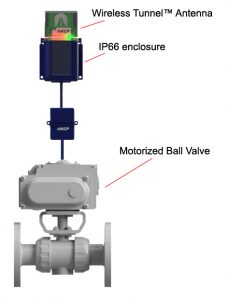
AKCP Wireless Valve Motor Control
Rope Water Sensor
With the ropeWater sensor, you can protect your essential equipment from potentially harmful water damage. Designed and manufactured by AKCP it forms an integral part of your solution for data center monitoring. The Rope Water sensor covers a large area and can be combined with any of our remote monitoring base units, or wireless tunnel sensors, it will give you advance notice of any water leaks or flooding. The sensor will retain its error condition until it is read via an SNMP. Therefore if the sensor encounters a critical condition at any time it will report that condition before it returns to a normal state.
Wireless Valve Control
Monitoring of pipe pressures and flow, controlling valves in buildings is important for the proper functioning of water distribution systems, prevent overpressure, and prolong the life of pipes and pumps. With Wireless Tunnel pipe pressure sensors, flow meters, valve controllers and variable frequency drives for pumps you can do all this, and more with our centralized monitoring platform, AKCPro Server
Reference Links:
https://www.capacitymedia.com/articles/3828778/schneider-unveils-world-first-liquid-cooled-pre-fab-facility
https://datacenterfrontier.com/the-evolution-of-data-center-cooling/
https://blog.samtec.com/post/immersion-cooling-now-on-samtec-com/

